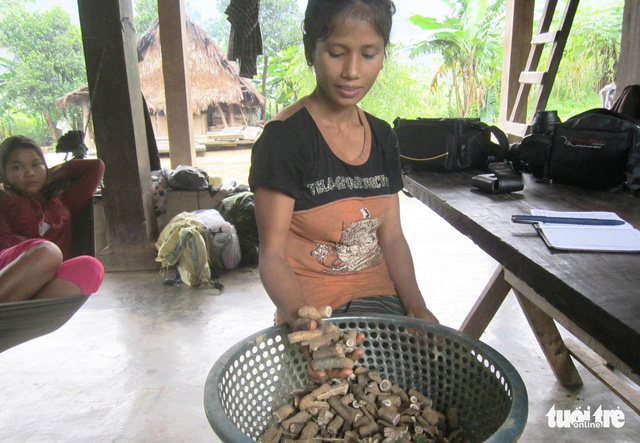Thanks to its close proximity to the famed Son Doong Cave in the north-central Vietnamese province of Quang Binh, the Doong mountain village has become a must-visit attraction for tourists before they explore the world’s biggest natural cave.
Doong is a small community of about 42 people belonging to the Bru – Van Kieu ethnic minority group. The village’s ‘primitive’ rustic charm, free from the exploitation that’s hit several other ethnic minority villages in the highlands, has made it top spot for explorers to visit on their way to Son Doong cave.
Natural beauty
Being a small unexplored mountain village, there is only one rocky trail leading to Doong and onward to the heart of Phong Nha – Ke Bang National Park, known for its greenery, dense trees, and countless of layers of leaves which appear to swallow anyone that walks in.
Being surrounded by thick layers of trees, even the hottest days seem comfortable in the shady village of Dong.
The trail leading to the village is dotted with animal footprints, lined with streams, and flanked by highlands. Tourists are often surprised when wild animals appear from behind rustling bushes as they make the three hour trek into Doong.
Doong sits atop a plateau nestled in the highlands, presented to those below as if upon a stage. And most visitors agree it’s well deserving of that spotlight. It’s seclusion has created a mixed aura of originality and mystery around the village.
Overlooking the village are layers of mountains that ‘guard’ it and watch over its residents.
As sun sets, patch of fog descend on the rooftops and clouds rest atop the mountains, juxtaposing the shiny green blanket of leaves and scorching hot sun that swallows the village in daytime.
Primitive village
Phong Nha – Ke Bang is one of the most well-preserved forests in Vietnam.
In the area near Doong lies a thousand-year-old tree with a trunk so big it takes 12 people to give it a hug.
Even though the village is located in the central region of Vietnam, one of the hottest areas of the country, its 1,000 meter altitude means temperatures rarely top 25 degrees Celsius.
The ideal weather turns the primitive community into an ideal stop after the long trek.
Here, tourists not only get the chance to see the beautiful scenery, but also the opportunity to experience the life of an ethnic minority member in a Vietnamese village.
As many say, Doong is wild, primitive, and naïve just like its people.
With no electricity, cement-covered streets, or phone service, one can take a break from a modern life while observing Doong villagers’ daily activities such as hunting and vegetable farming, in addition to trying out the local cuisine.
Many Doong villagers have never had an opportunity to leave the village, especially the children, and the presence of foreigners still needs some getting used to.
Being secluded from the rest of the society, Doong villagers maintain a type of self-sufficient economy which is becoming increasingly rare throughout the developing world.
Thanks to this system, the village is able to remain true to its traditions and avoid integration with the modern world.
Every five to seven days, male members of the community, along with their pack of dogs, set out into forest to hunt for animals.
The villagers do not use modern tools like guns and electric nets to hunt; instead they resort to the traditional way of surrounding their prey with the pack of dogs, and catching it after it gets exhausted from being chased.
According to Nguyen Van Tuong, a Doong villager, the community does not hunt rare or endangered animals in the forest.
“Even when we fish, we don’t dare catch more than we need since we have to leave some for other meals as well,” the villager said, explaining that they only use nets and hands to fish in order to maintain their delicate harmony with the environment.
Despite being poor, the villagers are generous towards tourists are rarely ask anything in return.
When the tourists pass the community, they are usually offered potato soup, or different kinds of potatoes native to the region.
After being warmly welcomed by Doong community, many tourists leave behind food to show the appreciation.
 |
A final stop before reaching Son Doong cave
With an increasing amount of people becoming interested in visiting Son Doong cave, many tourism companies try to differentiate themselves by including a trip to Doong in their tour packages.
Among many people who fell in love with the primitive village is Sheikh Hamad bin Hamdan Al Nahyan, a member of a ruling royal family of the United Arab Emirates who visited Son Doong cave in 2014.
What impressed him the most was the isolation and primitiveness of the community, as well as the naïve, surprised, and confused looks from the children there who had seen a middle-eastern men.
Al Nahyan is determined to come back to the village with his family.
Some tourist companies intend to work with villagers to turn the area into a tourist spot and improve the living standards of people here.
“We intend to let tourists stay in the village for longer periods of time so that they can experience more during their trip to Son Doong because Doong villagers still keep their cultural and traditional values,” a tourist company representative shared.
Like us on Facebook or follow us on Twitter to get the latest news about Vietnam!

















































